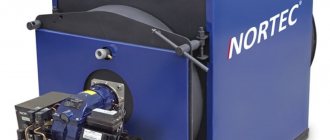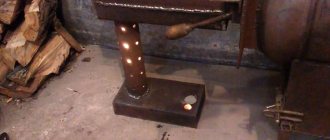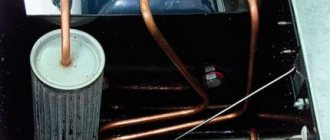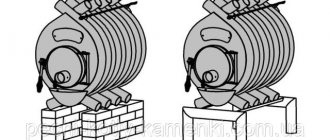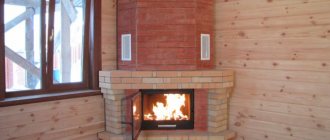Here you will learn:
- Advantages of waste furnaces
- Select a drawing
- Assembly sequence
- Starting a potbelly stove
- Work on other types of fuel
Used engine oil is an inexpensive and popular type of fuel. It is used for heating residential and non-residential premises by burning it in factory-made or home-made stoves and boilers. In this review, we will talk about one of these homemade products - this is a small but effective potbelly stove for testing. Characterized by its small dimensions and simple design, it produces a large amount of heat. In conclusion, we will talk about a combined unit that can work on mining and firewood.
Advantages of waste furnaces
It’s very easy to make a potbelly stove with your own hands. To do this, you will need skills in working with metal and a welding machine. A good master will cope with it literally in one day. It is the simple design that is the main advantage of this heating unit. The operating principle of the model we are considering is the creation and subsequent ignition of a combustible mixture of air and waste oil vapor .
We can say that the potbelly stove works on the principle of pyrolysis. After all, heat generation occurs in several steps:
- The oil is heated and burned in the first chamber at a low temperature.
- The combustion products remaining in the exhaust burn out in the second combustion chamber, which is connected to the first via a tube.
- Combustion products are sent into the chimney, while the resulting heat is directed to the heated room.
An oil stove, after it reaches operating mode, burns waste so completely and efficiently that we will practically not see any smoke from the chimney. If you expect black soot, like from an old diesel locomotive, then there will be nothing of the kind here - in operating mode, only whitish smoke comes from here, and in some cases this is not visible.
The potbelly stove is highly efficient during mining. Used oil is burned here completely and without residue. Due to this, the internal surfaces and components remain clean for a long time, without the need for frequent cleaning. Such stoves are often used to heat small workshops, private craft shops, and garages. Those who change oil in cars get a good profit in the form of a large amount of waste.
Equipment parameters
Potbelly stoves operating in mining have the following positive characteristics:
- size and other parameters can be selected by future users, so it is possible to obtain equipment that will be suitable for a specific structure that needs heating;
- oil-based products are cheap to operate;
- making them with your own hands is not difficult, and for this you must first draw a competent and up-to-date design diagram , and it is also advisable to watch a training video ;
- processing equipment heats up very quickly, so heated rooms quickly warm up ;
- The efficiency is high;
- the heat received from the operation of the stove is distributed evenly throughout the room;
- If you create a stove with your own hands, then you can create a hob in it, which will allow you to use the equipment not only for heating the room, but also for cooking and heating food.
However, products for which it is necessary to use processing have not only advantages, but also some disadvantages. These include:
- the room will be warm only if the potbelly stove is constantly running ;
- the working material must be constantly kept in the required quantity to warm up the equipment;
- It is imperative to install a chimney , which must be periodically maintained and cleaned of accumulated soot and dirt .
Select a drawing
Drawing of the most efficient potbelly stove using waste oil.
Let's look at the details - before us is a stove consisting of three main parts. Part one, the lowest, is a container with a small hole for pouring fuel and ignition. This container plays two roles - it acts as a tank and works as the primary combustion chamber. The container lid also serves as a kind of combustion intensity regulator.
The next part is a tube with holes that is welded to the lower container. The holes are used to take in secondary air. It mixes with the evaporating waste, resulting in the formation of a combustible mixture that burns to form a high-temperature flame. When the potbelly stove warms up and reaches operating mode, the pipe will literally hum under the pressure of the fire. The final combustion occurs in the upper chamber.
The upper chamber of our potbelly stove is round. But nothing prevents you from making it rectangular (like the bottom one). By increasing the area of the upper surface, you can create a kind of hob so that you can boil a kettle and warm up with a cup of warm drink. In the upper part of the second chamber of the potbelly stove we see a small pipe - it serves to connect the chimney. That's the whole scheme - simple and unpretentious.
Assembly sequence
A potbelly stove using waste oil will delight you with its quick assembly. It can be welded from the remains of an old gas cylinder or any other metal container of suitable diameter. It is also possible to assemble from sheet iron with preliminary cutting, giving it the desired shape and welding. The first task is to build the primary combustion chamber. Its diameter is 344 mm, height – 115 mm. A sealed bottom is welded to the bottom.

A well-assembled potbelly stove will provide good heat transfer with fairly modest oil consumption.
The stove itself is installed on metal legs of any design. In our case, they are made from a metal corner and have a height of 100 mm. There are four legs in total - a potbelly stove using oil (working off) must stand on the working surface as stable as possible, since liquid fuel is blazing inside it.
Next, we need to make a lid that fits tightly onto the main part of the primary tank of our potbelly stove. It is not flat - it is a piece of pipe with a diameter of 352 mm with a round sheet of the same diameter welded to it. Two holes are cut in the upper part - one with a diameter of 100 mm, which is used for welding a tube with holes, and the second with a diameter of 60 mm, which is used for filling the unit with waste and adjusting the air supply.
The lid for filling the potbelly stove with waste and adjusting the air supply is made of metal and placed on a rivet.
The next part is a vertical tube with a height of 360 mm and a diameter of 100 mm. It is necessary to drill 48 holes in it - 6 rows of 8 holes each, in a kind of checkerboard pattern. The first row is 20 mm from the bottom of the pipe, the last row is 55 mm from the top. The diameter of the holes for supplying secondary air to the stove is 9 mm. The waste will burn here, so you need a lot of air.
The next stage of making a potbelly stove during mining is the creation of a secondary chamber. Its diameter is 352 mm, for its construction you will need two covers, upper and lower. We make holes in both covers with a diameter of 100 mm, but not in the center, but 110 mm from the center (closer to the side). We weld a steel partition 330 mm long and 70 mm high from the inside to the top one. We weld the potbelly stove to burn the waste into a single whole, making sure that the holes in the lids are not on top of each other, but on opposite sides. We weld a chimney pipe with a height of 130 mm and a diameter of 100 mm to the top cover.
Final assembly
We have in our hands three parts of our potbelly stove:
- Primary container with a removable lid and a hole for pouring waste.
- Tube with holes for secondary air intake.
- Secondary combustion chamber with a pipe for the chimney.
At the final stage of assembly, we weld together the cover of the primary combustion chamber (the cover must remain removable), a pipe with holes and the secondary chamber. Now everything is ready for testing.
Starting a potbelly stove
Now we will learn how to heat a potbelly stove by working off. The task is to bring the furnace to operating mode. Cold mining is a combustible material, but it is not capable of producing a high-temperature flame. Therefore, it needs to be warmed up. We install the potbelly stove on a good foundation, connect the chimney to it - its recommended height is 4-5 meters. Next, we pour the waste into it.
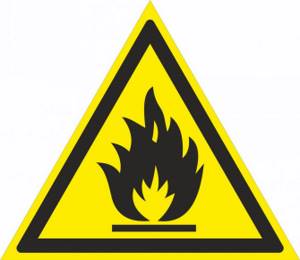
Do not try to use gasoline or other aggressively burning liquids here - their ignition can lead to serious burns and explosions.
At the next stage, we will need kerosene, which serves to speed up the ignition process. It is poured over the workings into the first chamber. Kerosene ignites softly, so it is suitable for our purposes. You can also use charcoal BBQ lighter fluids (slow burning).
We ignite our fuel mixture with a match (it’s better to throw a burning piece of paper into the tank), and adjust the supply of primary air. A burning flame will appear in the vertical perforated pipe. It will be slightly torn, since the potbelly stove is still cold. As it warms up, the flame will begin to brighten and hum – it should become almost white, with a slightly yellowish tint. Only in this case will the extraction release maximum thermal energy.
It is strictly forbidden to refuel the potbelly stove at full speed - wait until one portion burns out and only then fill in the next one. If you can’t stand it, increase the volume of the primary chamber. If this is not enough, weld a pipe to connect a metal fuel hose with an adjustment valve to the primary chamber of the potbelly stove. Connect this hose to a suitable large capacity fuel container. In this case, the potbelly stove will be able to burn indefinitely.
Basic safety measures:
- Clean the chimney regularly - the stability of combustion of waste in a potbelly stove depends on this.
- Do not use other types of fuel (for example, diesel fuel).
- Install the stove on a solid, non-combustible base. We strongly recommend making legs with holes for bolts - secure the primary chamber to prevent it from tipping over.
In addition, do not keep containers with flammable liquids near the stove. The distance to the nearest walls should not be less than 50 cm. To increase efficiency, we recommend covering the walls with galvanized iron to reflect the flow of thermal energy towards the room.
Useful tips
A potbelly stove will be easy to use if you listen to the recommendations of experts:
- To check the quality of welded joints, the first ignition is carried out outdoors.
- To ensure tightness, the chimney running inside the garage is made from an all-welded pipe without horizontal sections.
- There should be a box of sand and a fire extinguisher next to the stove.
- The places where the chimney pipe passes through the wall or ceiling are insulated with fireproof material.
- A brick screen lined on 3 sides of the stove will protect against accidental burns and retain heat after the fuel burns out. The distance from it to the walls of the potbelly stove should be 5 - 7 cm.
Despite its simple design, a potbelly stove is considered the most reliable and cheapest way to heat a garage. Even garbage can be burned in such a stove. When choosing, it should be taken into account that horizontal structures last longer than vertical ones.
Work on other types of fuel
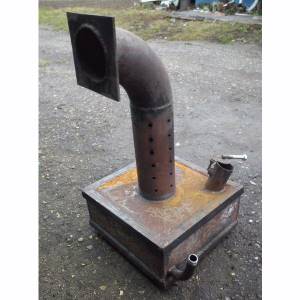
There is no need to bother with exact adherence to the millimeter - many craftsmen assemble potbelly stoves by working on them “by eye”, obtaining excellent results.
In our reviews, we have repeatedly published diagrams of conventional wood-burning stoves, including the pyrolysis type. They are made from sheet iron or old gas cylinders. Being equipped with large fireboxes, they allow you to burn almost any type of solid fuel. If you try, you can make a universal heating device - this is a wood-burning stove.
To do this, you will need an exhaust burner, shown in the figure below. Here we see the same primary combustion chamber with a perforated vertical tube connected to it. Only the final combustion will take place not in the secondary chamber, but in the chamber of the wood-burning stove. Your task is to arrange a removable door on it so that you can turn on the presented burner instead.
Converting a potbelly stove for mining is not particularly difficult - just use the diagrams and tips published in our review.
Main design features

Therefore, it is often possible to obtain the required amount of fuel completely free of charge. A potbelly stove can be purchased or created independently. Most often, people who already have this wood-burning stove want to improve it with their own hands, as a result of which the waste itself will act as fuel, or the joint use of these types of fuel is allowed.
In an oil stove, you can regulate the combustion intensity , for which you use the neck cover located in the lower part of the structure. If there is a need to quickly warm up a cold room, this lid must be opened completely . To maintain the optimal temperature in the room, the lid must be opened a few millimeters.
A product operating in mining requires a specialized chimney, which has quite a lot of requirements . This is due to the fact that its height should be approximately 4 meters , and its diameter cannot be less than 10 cm. It is advisable that the pipe be completely free of horizontal parts. To get good draft and prevent condensation from forming on the chimney, you need to insulate it outdoors with your own hands.

